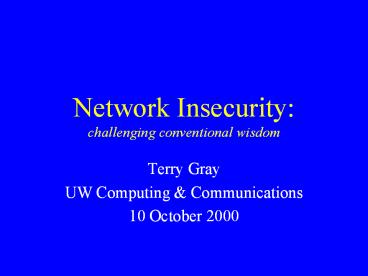Network Insecurity: challenging conventional wisdom - PowerPoint PPT Presentation
1 / 19
Title:
Network Insecurity: challenging conventional wisdom
Description:
'If you think technology can solve your security problems, then you don't ... eWeek 28 Sep 00. Suggestions. Do the application, host, and auth stuff. ... – PowerPoint PPT presentation
Number of Views:46
Avg rating:3.0/5.0
Title: Network Insecurity: challenging conventional wisdom
1
Network Insecuritychallenging conventional
wisdom
- Terry Gray
- UW Computing Communications
- 10 October 2000
2
Words to live by...
- If you think technology can solve your security
problems, then you don't understand the problems
and you don't understand the technology. Bruce
Schneier - Secrets and Lies
3
Start with a Security Policy
- Defining who can/cannot do what to whom...
- Identification and prioritization of threats
- Identification of assumptions, e.g.
- Security perimeters
- Trusted systems and infrastructure
- Policy drives securitylack of policy drives
insecurity
4
Approaches
- Operational Issues
- Prevention
- Detection
- Recovery
- Policy Issues
- Risk Management
- Liability Management
5
Policy Priorities
- Education/Awareness Security is everyones
responsibility there are no silver bullets. - Standards and adequate resources for computer
administration.
6
Technical Priorities
- Application security (e.g. SSH, SSL)
- Host security (patches, minimum svcs)
- Strong authentication (e.g. SecureID)
- Net security (VPNs, firewalling)
7
Network Security Axioms
- Network security is maximizedwhen we assume
there is no such thing. - Firewalls are such a good ideaevery host should
have one. - Remote access is fraught with periljust like
local access.
8
The SCCA VPN Issue
- Problems with border-to-border VPNs
- Costs a lot doesnt improve security
- Advantages of end-to-end strategies
- Needed anyway
- Misconceptions about the Gigapop
- Is it really a public network?
9
Perimeter Protection Paradox
- Firewall perceived value is proportional to
number of systems protected. - Firewall effectiveness is inversely proportional
to number of systems protected.
10
Network Risk Profile
11
Bad Ideas
- Departmental firewalls within the core.
- VPNs only between institution borders.
- Over-reliance on large-perimeter defenses...
- E.G. believing firewalls can substitute for good
host administration...
12
When do VPNs make sense?
- When legacy apps cannot be accessed via secure
protocols, e.g. SSH, SSL, K5. - AND
- When the tunnel end-points are on or very near
the end-systems.See also IPSEC enclaves
13
When does Firewalling make sense?
- Large perimeter
- To block things end-system administrators cannot,
e.g. spoofed source addresses. - When there is widespread consensus to block
certain ports. - Small perimeter/edge
- Cluster firewalls
- Personal firewalls
14
The Dark Side of Firewalls
- Large-perimeter firewalls are often sold as
panaceas but they dont live up to the hype,
because they - Assume fixed security perimeter
- Give a false sense of security
- May inhibit legitimate activities
- May be hard to manage
- Won't stop many threats
- Are a performance bottleneck
- Encourage backdoors
15
Even with Firewalls...
- Bad guys arent always "outside" the moat
- One persons security perimeter is anothers
broken network - Organization boundaries and filtering
requirements constantly change - Security perimeters only protect against a
limited percentage of threats must examine
entire system - Cannot ignore end-system management
- Use of secure applications is a key strategy
16
More words to live by...
- "It's naive to assume that just installing a
firewall is going to protect you from all
potential security threat. That assumption
creates a false sense of security, and having a
false sense of security is worse than having no
security at all."Kevin Mitnick - eWeek 28 Sep 00
17
Suggestions
- Do the application, host, and auth stuff.
- Try to cluster critical servers, then evaluate
additional protection measures... - Physical firewall protecting server rack?
- Local addressing NAT?
- IPSEC enclave?
- Logical firewall/Inverse VPN?
- Personal firewalls, e.g. ZoneAlarm?
18
Policy Procedure
- Need to work on policies, resources, and
consensus (e.g. re tightening perimeters.) - UW CC Efforts
- Dittrich Co.
- Trying to get more high-level support.
- Writing white papers.
- Pro-active probing.
- Security consulting services.
- IDS, attack analysis, etc.
- Virus scanning measures.
- Acquiring/distributing tools, e.g.SSH.
- Evaluating more aggressive port blocking.
19
Resources
- http//staff.washington.edu/gray/papers/credo
- http//staff.washington.edu/dittrich
- http//www.sans.org/































